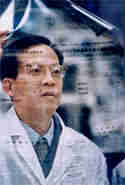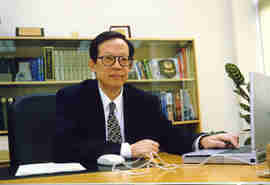He has been vice-chairman of the 10th Central Committee of Jiu San Society since 1995, and also the vice chairman of the 10th CPPCC (National Committee of the Chinese People’s Political Consultative Conference).
 Enormous Contributions to China's Press and Printing Industry
Enormous Contributions to China's Press and Printing Industry

|
| Looking at the newspaper films produced with laser photo typesetting system |
During his first ten years of work at his alma mater after graduation, Wang accumulated practical experiences in the fields of computer software and hardware. So in 1961, he started his research on the combination of software and hardware, undertaking the exploration of a high-level language programming system.
The 1970s saw humankind step into an age of information exploration. China, as the birthplace of printing, launched an important research project -- "748 Project," which mainly focused on Chinese character processing. There were three sub-projects, and Wang was in charge of the research and development of a precision photo-typesetting system for Chinese characters .
Prior to the project, many companies and individuals had been engaged in the research on the typesetting of Chinese characters, but without achieving anything substantial. Wang Xuan, with the foresight and sagacity of a scientist, sensed the impending opportunity. Though well aware of the grand mission of invigorating China's national industry, he dauntlessly shouldered the project.
In 1976, Wang worked out a plan to directly manufacture a fourth-generation laser photo-typesetting system instead of just making a transition from the second and third generations of photo typesetting, which meant he would have to finish the work that took western countries 40 years to accomplish.
With regard to the characteristics and difficulties of publishing Chinese characters, he invented the high-efficiency compression and restoration method. He also took the lead in designing a special chip for the system. He was also the first to use control information (parameters) to describe the characteristics of breadth, which he has patented in Europe and China.

|
| Professor Wang Xuan in his office |
In July of 1979, the research on laser photo-typesetting system of Chinese characters achieved preliminary results. In 1985, II-type system was put into productive use, and was given the first-prize National Awards for Science and Technology Progress in 1987 and 1995. Besides, the invention was twice listed as one of the Top Ten National Scientific Achievements. As the only four-time winner of state-level awards, Wang Xuan's invention is hailed as the greatest one within the 1000-plus years after the invention of movable type printing in Chinese printing history.
December 2, 1987 was a historical day that will long be remembered by Wang Xuan and his fellow researchers. With the help from cooperation units, the typesetting workers of The Economic Daily used the laser photo typesetting by computer for the first time, leaving behind the low-efficiency and poisonous letterpress printing, which signaled that China's printing had entered the era of "light and electricity."
In 1988, Wang worked on and formed a Chinese-language newspaper editing and a publishing system using large computer terminals; a Chinese-language laser typesetting system for color printing; a teletransmission publishing system; and a management system for news collection and editing. These technologies can compete with the best in the world.
